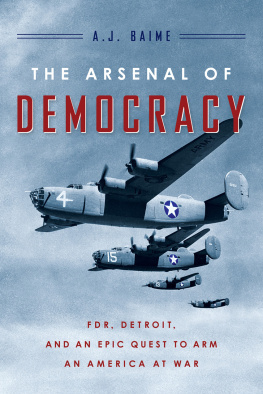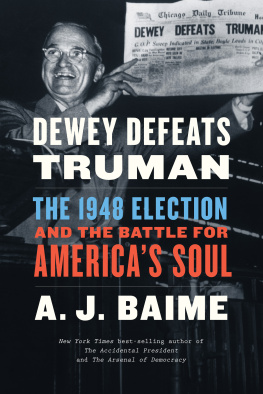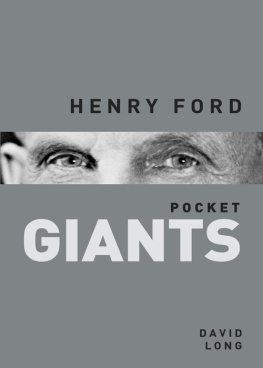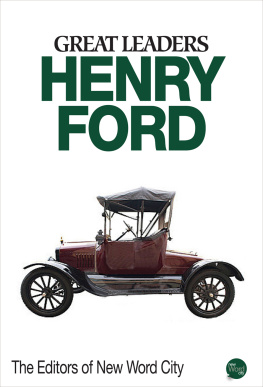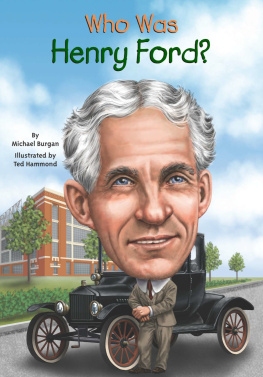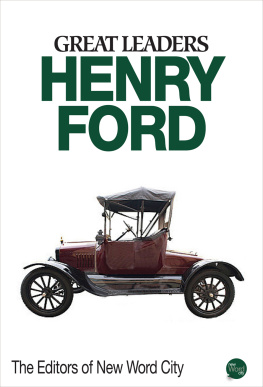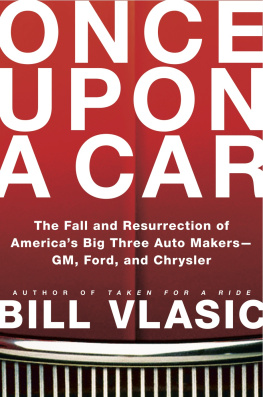Copyright 2014 Albert Baime
All rights reserved
For information about permission to reproduce selections from this book, write to Permissions, Houghton Mifflin Harcourt Publishing Company, 215 Park Avenue South, New York, New York 10003.
www.hmhco.com
The Library of Congress has cataloged the print edition as follows:
Baime, A. J. (Albert J.)
The arsenal of democracy : FDR, Detroit, and an epic quest to arm an America at war / A. J. Baime.
pages cm
Includes bibliographical references and index.
ISBN 978-0-547-71928-3
1. Ford Motor CompanyHistory20th century. 2. Industrial mobilizationUnited StatesHistory20th century. 3. Automobile industry and tradeMilitary aspectsUnited StatesHistory20th century. 4. Willow Run (Manufacturing plant)History20th century . 5. B-24 (Bomber)Design and constructionHistory. 6. Ford, Edsel, 18931943. 7. Ford, Henry, 18631947. 8. Ford, Henry, II, 19171987 9. World War, 19391945Economic aspectsUnited States. 10. World War, 19391945Michigan. I. Title. II. Title: FDR, Detroit, and an epic quest to arm an America at war.
HD9710.U54B35 2014
940.53'1dc23
2013045019
e ISBN 978-0-547-83444-3
v2.1014
Every single man, woman, and child is a partner in the most tremendous undertaking of our American history.
F RANKLIN D. R OOSEVELT
I refuse to recognize that there are impossibilities. I cannot discover that anyone knows enough about anything on this earth definitely to say what is and what is not possible.
H ENRY F ORD
Cover image: B-24 Liberator bombers in flight on May 19, 1942. Maximum speed: 303 miles per hour. Range: 2,850 miles. Engines: four Pratt & Whitney R-1830s totaling 4,800 horsepower. Armament: ten .50 caliber machine guns and 8,000 pounds of bombs.
Introduction
T HIS BOOK IS ABOUT many things. Its about World War II. Its about the rise of airpower, an apocalyptic science when applied to military action. Its about an American president confined to a wheelchair who sought to teach the world how to walk again during the Great Depression, only to find himself facing a losing war against unconscionable evil. Its about Detroitthe biggest wartime boomtown of alland its automobile industry, which in 1941 had a bigger economy than any foreign nation except Britain, France, Germany, and possibly the Soviet Union. Ultimately, this book is about a father and a son who more than any other figures in the first half of the twentieth century symbolized Americanism all over the worldtheir love, their empire, and the war that tore them apart.
In 1941 Henry Ford and his only child, Edsel, launched the most ambitious wartime industrial adventure ever up to that point in history. They attempted to turn their motorcar business into an aviation powerhouse, to build four-engine bombers, the weapon the Allied leaders thirsted for above all others. The older Ford (Henry was seventy-six when the war began) was one of the nations richest and most controversial men, an ardent antiwar activist and accused Nazi sympathizer. His only child, Edsel, was a tragic Gatsby-esque character who was dying of a disease that all his riches couldnt cure.
With the help of Cast Iron Charlie Sorensen, Detroits heralded Hercules of the assembly lines, and the aviator Charles Lindbergh, the Fords attempted to turn the US Air Corps biggest, fastest, most destructive heavy bomber into the most mass-produced American aircraft of all time. Their quest captured the imagination of a nation and came to illuminate all that could go wrong on the home front during the warand all that could go right.
At the same time, the Fords were being quietly investigated by US Treasury agents, who believed the familys ties to its French divisionwhich was cooperating with the Nazi high command to help build Hitlers arsenalmay have violated the Trading with the Enemy Act. An investigation kicked into high gear in 1943, the day a strictly confidential memo landed on Roosevelts desk in the White House detailing amazing and shocking correspondence between Edsel Ford and a key French operative. Did the family have a dark secret?
Honor, betrayal, sacrifice, deathall of it is woven into a father-son drama that, in the larger context of the war, has never fully been explored.
In the climactic scenes of this book, the reader will be transported into battle aboard bombers built by the Fords. Here was the power, Lindbergh said of these 60,000-pound machines (fully loaded), the efficiency, the superhuman magic of which we had dreamed. Henry Fords vision in the early part of the century, Fordism, had fueled the rise of cities, suburbs, and industries. Nowinside enemy territorythat same vision would tear it all down.
Today Detroit gets trotted out as a symbol of a superpower in decline. The city has lost more than half its population since the war, and it is the largest American city ever to declare bankruptcy. Its main artery, the Edsel Ford Expressway, runs right into it, though the man it is named for is all but forgotten. There was a time, however, when Detroit was a city of destiny, a city forging thunderbolts. This is a book about World War II and the Motor Cityits heroes, its villains, and its legacy.
Prologue
O N THE NIGHT OF December 29, 1940, a few moments before 9:00 PM , Franklin Delano Roosevelt wheeled himself in his chair through the White House warrens and into the Diplomatic Reception Room on the first floor. He wore a gray wool suit and a face that, for an eternal optimist, appeared grim. An incongruous audience stood in the room. The Presidents mother was there, as were some White House guests, actors Clark Gable and Carole Lombard. Roosevelt was preparing to deliver an address that generations hence would deem one of the most important pieces of political rhetoric in modern history. It was called The Arsenal of Democracy.
At that very moment, in London, bombs were raining from the night sky. Adolf Hitlers air force was subjecting London to the worst pounding since the start of the Battle of Britaina night of terror planned specifically to steer attention away from Roosevelts speech, which promised to solve a great mystery: what was the President prepared to do about the Nazis and their conquering armies? With most of Europe already subjugated, would Washington remain neutral? Or was Roosevelt prepared to support the effort to defeat Hitler with American-made tanks, guns, ships, and bomber aircraft?
All week long the White House had stirred with activity in anticipation of the Presidents fireside chat. On the Sunday of the address, Roosevelt worked over every word in his office, complaining to his secretary, Grace Tully, who went heavy on the punctuation when she typed.
Grace! he yelled. How many times do I have to tell you to stop wasting the taxpayers commas?
When he was satisfied, he sent the speech to the State Department for comment. He had his throat sprayed to ease his sinuses. White House workers removed the gold-trimmed presidential china from the Diplomatic Reception Room, and as Roosevelt sipped cocktails and ate dinner, they tested the broadcasting equipment, the wires snaking across the floor onto a desk on which a cluster of microphones stoodthe ears of the world.
At the stroke of nine, the largest radio audience ever gathered tuned in. Over five hundred stations were broadcasting the speech in the United States. This was the Golden Age of Radio, with popular shows like Jack Benny and Amos n Andy, and yet no broadcast had ever lured more attention than the Presidents speech. The only one that had come close was the Joe LouisMax Schmeling fight at Yankee Stadium two years earlier.
Amid the rubble of Britains cities, at 3:00 AM London time, thousands, including Prime Minister Winston Churchill, crowded around their radios. Roosevelts address would be broadcast in South America, China, the Soviet Union, and in six languages in Europe.
Next page
